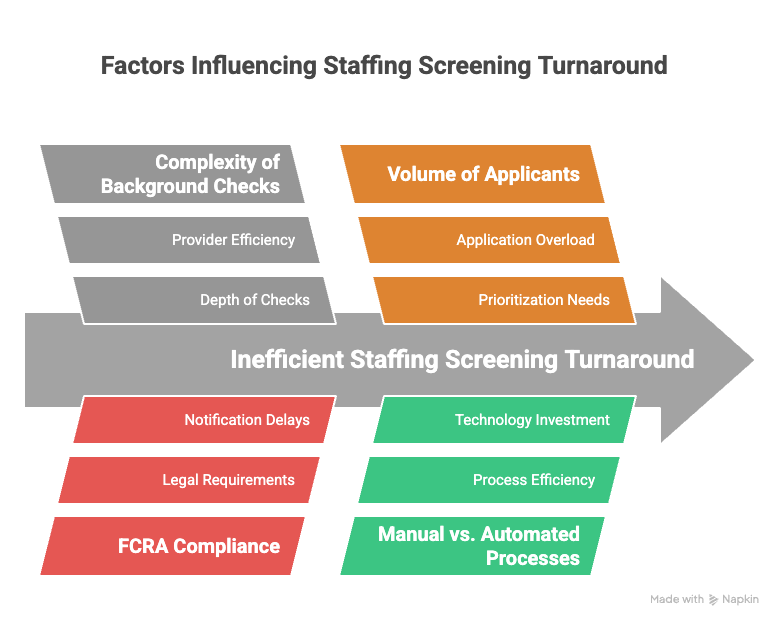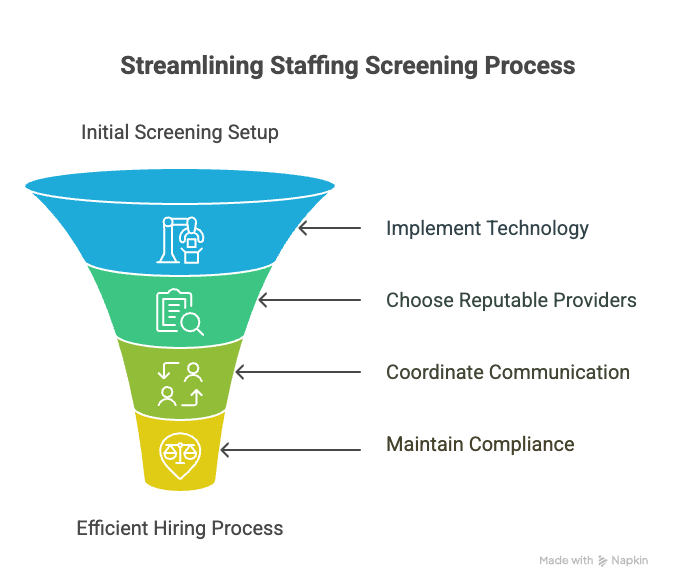In the fast-paced world of recruitment, the efficiency of staffing screening processes directly impacts hiring decisions and the overall speed of onboarding new employees. Whether you're a hiring manager aiming to streamline operations or a candidate eager to know what to expect, understanding the intricacies of staffing screening turnaround is crucial. Let's dive into the factors influencing these timelines and explore industry best practices for optimizing the process.
Key Takeaways
- Quick and precise staffing screening is crucial for staying competitive in hiring.
- Streamlining background, reference, skills, and drug checks can significantly improve hiring speed.
- Key factors affecting screening time include the complexity of checks, legal compliance, applicant volume, and use of technology.
- Average turnaround times vary, but leveraging automated systems can enhance efficiency and reduce delays.
- Embracing the right tools, enhancing communication, and staying aligned with regulations bolster the screening process and candidate experience.
Introduction
Getting the right person into the right role quickly can make all the difference. In a competitive job market, speed and precision in staffing screening aren't just good practice, they're essential. Imagine waiting weeks to get a new hire over the line—that's time lost, productivity sacrificed, and potentially, the best candidates slipping away to faster-moving rivals. Staffing screening is the backbone of efficient hiring, and turnaround times are the heart that keeps it all beating.
This isn’t about cutting corners; it’s about efficiency in a process that demands accuracy and legal compliance. Understanding what influences these timelines is your first step. We'll explore the standard turnaround times, factors that can stretch or shrink them, and actionable strategies to optimize your process. By the end, you'll be equipped with the insights needed to make your recruitment as agile as the talent you seek to attract.
EXPERT INSIGHT: With staffing screenings, speed is a hiring make-or-break factor. Delays lose productivity and can cost you talent. Screening efficiently shows respect for the candidate's time and your urgency as an employer. The appropriate tools and open communication convey to applicants that we treat them and the position with respect and care. Quicker, more equitable screening fosters trust, and trust is at the heart of an excellent hire. - Charm Paz, CHRP
What is Staffing Screening?
Staffing screening is a critical step in the hiring process that ensures candidates meet the necessary qualifications and standards for a job. Think of it as the checkpoint that validates if someone is a good fit for a role before they join a company.
Key Components:
- Background Checks: These are essential to verify a candidate's history. They can include criminal record checks, employment history, and educational verification. Background checks help confirm that candidates are who they claim to be and have the qualifications they list.
- Reference Checks: This step involves contacting former employers or colleagues to get insights into a candidate's past performance, work habits, and character. Reference checks help build a fuller picture of the candidate's capabilities and potential fit with the company culture.
- Skills Assessments: These tests evaluate a candidate’s abilities in specific areas required for the job. For example, a writing test for a content creator role or a coding challenge for a software developer. Skills assessments ensure that candidates possess the practical skills needed to succeed in their roles.
- Drug Testing: Often a requirement for safety-sensitive jobs, drug testing checks for the use of illegal substances. This helps maintain a safe and productive work environment.
Staffing screening is about making informed hiring decisions. It aims to reduce risks and ensure that new hires align with company policies and job requirements. Understanding the components of staffing screening can help you prepare effectively, whether you are hiring or applying for a job. For employers, it is a chance to show respect for candidates by doing it with care and with full disclosure. For candidates, it is reassuring to know that the goal goes beyond simply considering them; it is to find them a position to genuinely succeed at.
Factors Influencing Staffing Screening Turnaround
The efficiency of staffing screening largely hinges on several key factors that you should consider if you're looking to improve or understand the process better.

Complexity of Background Checks: The depth and breadth of background checks directly influence how quickly they can be completed. For example, verifying past employment and education might be quick, but criminal checks can vary by county and state regulations. Seeking out the fastest background check providers could shave days off your timeline, yet ensure they maintain accuracy and compliance.
FCRA Compliance: The Fair Credit Reporting Act (FCRA) sets the legal parameters for how background checks are conducted. Ensuring compliance is critical but can add to the timeline. Pre-adverse and adverse action notifications, required under FCRA, mean you must wait for a response from the candidate, introducing built-in delays. Understanding these legal requirements can help you better prepare and manage expectations.
Volume of Applicants: A higher volume of applicants can naturally slow down the screening process. When you receive hundreds of applications, each requiring careful checking, bottlenecks can occur. Consider staggering the process or prioritizing candidates to maintain efficiency.
Manual vs. Automated Processes: Traditional manual methods are time-consuming and prone to error, whereas automated tools can streamline operations significantly. Automations can handle large data volumes and complete repetitive tasks quickly. While upfront investment in technology might seem high, the long-term savings in time and reduced error rates often justify it.
Each factor plays a distinct role, and by addressing them, you can significantly impact the speed and effectiveness of your staffing screening process. How can you adjust your current processes to improve turnaround times while still maintaining accuracy and compliance?
Average Turnaround Times for Different Screening Components
Background Checks
Background checks typically take between one to five business days. Various factors can influence this timeframe, including the depth of the investigation and the responsiveness of educational or past employment verifications. For faster results, some companies use advanced databases and digital solutions that often require just a couple of days. However, if international records are needed or if there are discrepancies in the information provided by the candidate, expect delays.
Reference Checks
Reference checks commonly take three to five days to complete. Much depends on the promptness and availability of the references. Streamlining this process can involve asking candidates to notify their references in advance or using email templates that facilitate quicker responses. Automated reference-checking systems can also shave days off the waiting period by efficiently collecting insights from multiple references simultaneously.
Skills Assessments
Skills assessments usually take one to three days, given that many are conducted online. Technology plays a crucial role here, with platforms offering immediate scoring and feedback. When employers customize assessments too heavily or need manual reviews of coding tasks or portfolios, completion times can stretch longer. For rapid turnover, make sure the tests are relevant, concise, and fully automated when possible.
Drug Testing
Standard drug testing can take anywhere from 24 hours to several days, depending on the type of test and location of the testing facility. Urinalysis, often the most common form, provides rapid results, typically within one to two business days. Tests requiring more comprehensive laboratory analysis or dealing with positive results that demand further examination will naturally extend the timeline. Quick communication between testing agencies and employers can aid in navigating delays more effectively.
By understanding these timeframes, you can better manage your expectations and plan the recruitment process to maintain momentum and efficiency.
Improving Turnaround Times: Best Practices
Speeding up staffing screening processes can save time and resources. Your first stop should be technology. Automated screening tools reduce manual tasks and errors. They can quickly handle background checks or skills assessments, slashing wait times.
Next, go with reputable providers. Find those who offer the fastest and most reliable background checks. Checking reviews and getting recommendations from industry peers can help pinpoint the best choices.
Coordination is also crucial. Clear communication between HR, recruiters, and screening agencies can smooth the process. Sticking to an organized timeline and sharing updates ensures everyone is on the same page.
Lastly, keep abreast of regulations. Staying FCRA compliant is mandatory and can prevent legal hiccups that stall progress. Regular updates and staff training sessions can keep your team informed without bogging down the workflow.

These steps can significantly cut down screening time, giving you a streamlined hiring process without compromising on thoroughness or compliance.
Conclusion
Fast turnaround times in staffing screening can greatly improve the hiring process for both employers and candidates. When screening is quick, it enhances the experience for applicants. Imagine going through the recruitment steps without unnecessary delays. You feel valued and eager to join the new workplace. This positive experience can influence your decision about accepting an offer.
From the employer's point of view, a seamless process gives a competitive edge. Top talent often has several options. If you can make decisions quickly, you’re more likely to secure the best candidates. No one wants to miss out on a qualified applicant because of a slow procedure. Fast screening means staying ahead in the recruitment race and strengthening your team with top-tier choices.
There’s also the benefit of reduced time-to-hire. When background checks, reference checks, and other evaluations are completed promptly, vacancies are filled faster. This minimizes productivity loss and helps maintain operational flow. A quick hiring process also reflects positively on company culture, showcasing efficiency and a forward-thinking approach.
In short, speed in screening isn’t just about moving fast. It’s about enhancing each step of the hiring journey, creating a win-win for everyone involved.
Resources
Having the right tools and resources at your disposal can make a significant difference in managing staffing screening processes effectively. Internally, using streamlined applicant tracking systems can enhance communication and workflow between HR teams and hiring managers. Utilizing platforms like the GCheck blog can provide up-to-date insights and strategies for improving screening processes. These resources often offer practical advice, industry trends, and example case studies that can help inform better decision-making.
Externally, staying informed about legal regulations through authoritative sites like the Department of Labor is crucial. It offers guidance on various compliance standards, helping to ensure your processes align with legal requirements. Regularly checking such resources keeps you informed of any regulatory changes that might affect screening procedures.
These tools and resources pave the way for a more expedient and compliant hiring process. Are you using the most effective tools for your screening needs?
The importance of managing staffing screening turnaround times effectively cannot be overstated. Quick, thorough screenings lead to better hiring decisions and faster onboarding, making your organization more attractive to top talent. As you look to improve your recruitment process, consider adopting automated tools and fostering better communication within your team to reduce delays.
To stay ahead, keep refining your processes and incorporate new technologies as they become available. This will not only enhance your hiring speed but also improve the overall candidate experience, giving your organization a competitive edge in the hiring landscape. Staying agile and responsive to changes in regulations and technology will ensure your screening process remains efficient and effective.
Frequently Asked Questions (FAQs)
What is the average time for a staffing agency background check?
On average, a staffing agency background check takes between three to five business days. This time frame can vary depending on the specific checks conducted and the response speed of the institutions contacted.
How can staffing agencies speed up background checks?
To expedite background checks, ensure all necessary information from candidates is collected upfront. Using digital platforms that integrate directly with databases can reduce processing time. Additionally, developing strong partnerships with reliable vendors can improve efficiency.
Do criminal background checks delay hiring?
Criminal background checks can delay hiring, especially if they are thorough. Delays may occur when records are outdated or require manual verification. However, using modern technology and reliable systems can minimize these hurdles.
What causes delays in employment verification?
Delays in employment verification often occur due to slow responses from previous employers, inaccurate contact information, or a lack of automated systems. Encouraging candidates to inform their former employers about the upcoming verification can sometimes speed up the process.
Are instant background checks reliable for staffing?
Instant background checks provide quick results but often lack comprehensive detail. While they are useful for preliminary screenings, they should be supplemented with more detailed checks to ensure accuracy and completeness.
What information is typically included in a background check?
A typical background check includes identity verification, employment history, credit check, criminal record, and education verification. The specific components may depend on the job role and industry requirements.
How often should background checks be updated?
Background checks should ideally be updated before initial hiring and periodically during employment, especially if the role involves security or financial responsibilities. Regular updates help ensure ongoing compliance and safety.
What legal considerations should staffing agencies keep in mind regarding background checks?
Staffing agencies must comply with the Fair Credit Reporting Act (FCRA) and local regulations. They should obtain written consent from candidates and ensure the process is transparent, allowing candidates to dispute any inaccuracies.
How can candidates prepare for a background check?
Candidates can prepare by ensuring their records are accurate. They should review their credit history and criminal records, inform references about potential contact, and provide complete and honest information to minimize delays.
Definitions
Staffing Screening
Staffing screening is the process of checking whether a job candidate meets the requirements of a role before hiring. It involves confirming their background, qualifications, and suitability through tools like background checks, skills tests, and reference calls. The goal is to reduce hiring errors and ensure a better fit between the candidate and the company.
Background Checks
A background check verifies key parts of a candidate’s personal and professional history. It can include employment history, criminal records, education, and identity. Employers use these checks to confirm facts and reduce risks related to fraud or safety. For example, confirming that a candidate really worked for a previous employer or holds a claimed degree.
Reference Checks
Reference checks involve contacting a candidate's former supervisors or colleagues to learn about their past job performance. Employers use this step to gather insights not found in resumes or interviews. A solid reference can confirm how a person handles feedback, meets deadlines, or works with others.
Skills Assessments
Skills assessments measure how well a candidate can perform tasks required for the job. They can be online tests, written exercises, or practical challenges like coding tasks. These assessments help employers evaluate capabilities beyond what resumes or interviews show. For instance, a designer might be asked to complete a layout project.
FCRA Compliance
FCRA compliance means following the Fair Credit Reporting Act when conducting background checks. This law protects job candidates by requiring employers to get written consent and provide notices if any negative action is based on the report. If you withdraw an offer because of a background check, you must first share a copy and allow the candidate to respond.

